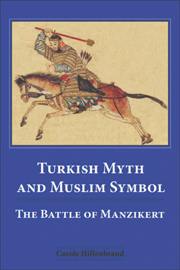Book contents
- Frontmatter
- Contents
- List of figures
- List of plates
- Acknowledgements
- Comment on transliteration and conventions used in the book
- Dedication
- Part 1 Medieval Muslim interpretations of the battle of Manzikert
- Part 2 The legacy of the battle
- Conclusion
- Appendix A The account of the battle of Manzikert by Michael Attaleiates, translated by Ruth Macrides
- Appendix B Translations of some other medieval Christian accounts of the battle of Manzikert
- Appendix C Other medieval Muslim accounts of the battle of Manzikert
- Bibliography
- Index
- Plate section
Conclusion
Published online by Cambridge University Press: 05 August 2013
- Frontmatter
- Contents
- List of figures
- List of plates
- Acknowledgements
- Comment on transliteration and conventions used in the book
- Dedication
- Part 1 Medieval Muslim interpretations of the battle of Manzikert
- Part 2 The legacy of the battle
- Conclusion
- Appendix A The account of the battle of Manzikert by Michael Attaleiates, translated by Ruth Macrides
- Appendix B Translations of some other medieval Christian accounts of the battle of Manzikert
- Appendix C Other medieval Muslim accounts of the battle of Manzikert
- Bibliography
- Index
- Plate section
Summary
An attempt has been made in this book to tease out the tension between ‘fact’ and ideology in the Muslim historiographical tradition about the battle of Manzikert and to analyse the way in which the Islamic sources in their accounts of the battle construct an image of Seljuq Turkish rule.
Medieval chroniclers, Muslim and Byzantine alike, correctly perceived this battle as a pivotal event in the perennial conflict between Christianity and Islam. This awe-inspiring context of salvation history lent an extra charge of, so to speak, eternal significance to the Turkish role in this seminal victory, a victory which delivered Anatolia into the ‘House of Islam’. Much could be forgiven the architects of that victory and so, despite the depredations and alien ways of the Turks as invading nomads, Manzikert became an instrument for their rehabilitation – and even glorification – in the Arab and Persian consciousness.
Manzikert is the principal set piece in Seljuq historiography; and it is conveniently close to the chronological starting point of the dynasty. The other important military achievement of the Seljuqs in the early period after their entry into Islamic lands – their victory at the key battle of Dandanqan in Central Asia against the Ghaznavids in 1040 which opened up the Iranian plateau to them – does not receive anything like the same kind of treatment from the pens of Muslim historians. Why is this?
- Type
- Chapter
- Information
- Turkish Myth and Muslim SymbolThe Battle of Manzikert, pp. 226 - 228Publisher: Edinburgh University PressPrint publication year: 2007



